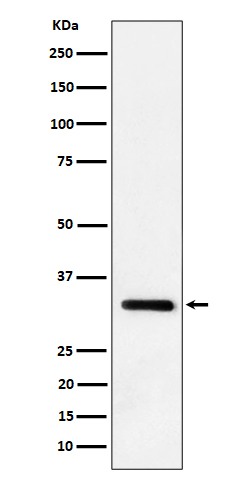Anti-IL-33 Rabbit Monoclonal Antibody
- SPECIFICATION
- CITATIONS
- PROTOCOLS
- BACKGROUND

Application
| WB, IHC, IF, ICC |
|---|---|
| Primary Accession | Q8BVZ5 |
| Host | Rabbit |
| Isotype | IgG |
| Reactivity | Rat, Mouse |
| Clonality | Monoclonal |
| Format | Liquid |
| Description | Anti-IL-33 Rabbit Monoclonal Antibody . Tested in WB, IHC, ICC/IF applications. This antibody reacts with Mouse, Rat. |
| Gene ID | 77125 |
|---|---|
| Other Names | Interleukin-33, IL-33, Interleukin-33(102-266), Interleukin-33(109-266), Il33 {ECO:0000312|MGI:MGI:1924375} |
| Calculated MW | 31 kDa |
| Application Details | WB 1:500-1:2000 IHC 1:50-1:200 ICC/IF 1:50-1:200 |
| Contents | Rabbit IgG in phosphate buffered saline, pH 7.4, 150mM NaCl, 0.02% sodium azide and 50% glycerol, 0.4-0.5mg/ml BSA. |
| Clone Names | Clone: 28I14 |
| Immunogen | A synthesized peptide derived from human IL-33 |
| Purification | Affinity-chromatography |
| Storage | Store at -20°C for one year. For short term storage and frequent use, store at 4°C for up to one month. Avoid repeated freeze-thaw cycles. |
| Name | Il33 {ECO:0000312|MGI:MGI:1924375} |
|---|---|
| Function | Cytokine that binds to and signals through the IL1RL1/ST2 receptor which in turn activates NF-kappa-B and MAPK signaling pathways in target cells (PubMed:29045903). Involved in the maturation of Th2 cells inducing the secretion of T-helper type 2-associated cytokines (By similarity). Also involved in activation of mast cells, basophils, eosinophils and natural killer cells (By similarity). Acts as an enhancer of polarization of alternatively activated macrophages (By similarity). Acts as a chemoattractant for Th2 cells, and may function as an 'alarmin', that amplifies immune responses during tissue injury (By similarity). Induces rapid UCP2-dependent mitochondrial rewiring that attenuates the generation of reactive oxygen species and preserves the integrity of Krebs cycle required for persistent production of itaconate and subsequent GATA3-dependent differentiation of inflammation-resolving alternatively activated macrophages (PubMed:34644537). |
| Cellular Location | Nucleus. Chromosome {ECO:0000250|UniProtKB:O95760}. Cytoplasm {ECO:0000250|UniProtKB:O95760}. Cytoplasmic vesicle, secretory vesicle {ECO:0000250|UniProtKB:O95760}. Secreted. Note=Secreted and released in the extracellular milieu by passing through the gasdermin-D (GSDMD) pore following cleavage by CELA1 (PubMed:35749514, PubMed:35794369) Associates with heterochromatin and mitotic chromosomes (By similarity). The secretion is dependent on protein unfolding and facilitated by the cargo receptor TMED10; it results in protein translocation from the cytoplasm into the ERGIC (endoplasmic reticulum- Golgi intermediate compartment) followed by vesicle entry and secretion (By similarity). {ECO:0000250|UniProtKB:O95760, ECO:0000269|PubMed:35749514, ECO:0000269|PubMed:35794369} |

Thousands of laboratories across the world have published research that depended on the performance of antibodies from Abcepta to advance their research. Check out links to articles that cite our products in major peer-reviewed journals, organized by research category.
info@abcepta.com, and receive a free "I Love Antibodies" mug.
Provided below are standard protocols that you may find useful for product applications.
If you have used an Abcepta product and would like to share how it has performed, please click on the "Submit Review" button and provide the requested information. Our staff will examine and post your review and contact you if needed.
If you have any additional inquiries please email technical services at tech@abcepta.com.













 Foundational characteristics of cancer include proliferation, angiogenesis, migration, evasion of apoptosis, and cellular immortality. Find key markers for these cellular processes and antibodies to detect them.
Foundational characteristics of cancer include proliferation, angiogenesis, migration, evasion of apoptosis, and cellular immortality. Find key markers for these cellular processes and antibodies to detect them. The SUMOplot™ Analysis Program predicts and scores sumoylation sites in your protein. SUMOylation is a post-translational modification involved in various cellular processes, such as nuclear-cytosolic transport, transcriptional regulation, apoptosis, protein stability, response to stress, and progression through the cell cycle.
The SUMOplot™ Analysis Program predicts and scores sumoylation sites in your protein. SUMOylation is a post-translational modification involved in various cellular processes, such as nuclear-cytosolic transport, transcriptional regulation, apoptosis, protein stability, response to stress, and progression through the cell cycle. The Autophagy Receptor Motif Plotter predicts and scores autophagy receptor binding sites in your protein. Identifying proteins connected to this pathway is critical to understanding the role of autophagy in physiological as well as pathological processes such as development, differentiation, neurodegenerative diseases, stress, infection, and cancer.
The Autophagy Receptor Motif Plotter predicts and scores autophagy receptor binding sites in your protein. Identifying proteins connected to this pathway is critical to understanding the role of autophagy in physiological as well as pathological processes such as development, differentiation, neurodegenerative diseases, stress, infection, and cancer.


